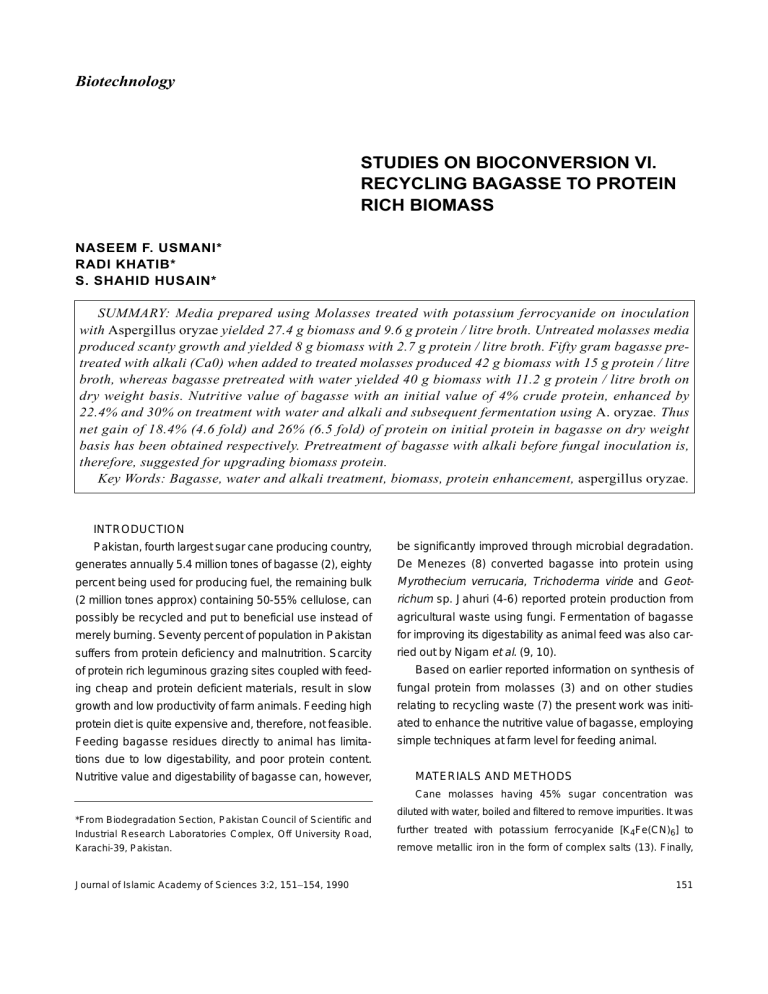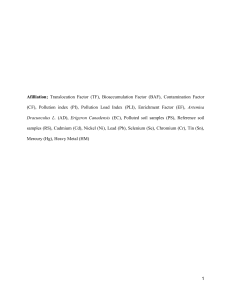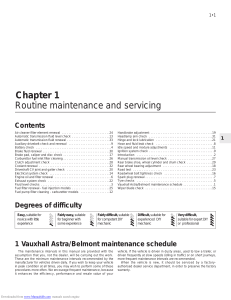
Biotechnology
STUDIES ON BIOCONVERSION VI.
RECYCLING BAGASSE TO PROTEIN
RICH BIOMASS
NASEEM F. USMANI*
RADI KHATIB*
S. SHAHID HUSAIN*
SUMMARY: Media prepared using Molasses treated with potassium ferrocyanide on inoculation
with Aspergillus oryzae yielded 27.4 g biomass and 9.6 g protein / litre broth. Untreated molasses media
produced scanty growth and yielded 8 g biomass with 2.7 g protein / litre broth. Fifty gram bagasse pretreated with alkali (Ca0) when added to treated molasses produced 42 g biomass with 15 g protein / litre
broth, whereas bagasse pretreated with water yielded 40 g biomass with 11.2 g protein / litre broth on
dry weight basis. Nutritive value of bagasse with an initial value of 4% crude protein, enhanced by
22.4% and 30% on treatment with water and alkali and subsequent fermentation using A. oryzae. Thus
net gain of 18.4% (4.6 fold) and 26% (6.5 fold) of protein on initial protein in bagasse on dry weight
basis has been obtained respectively. Pretreatment of bagasse with alkali before fungal inoculation is,
therefore, suggested for upgrading biomass protein.
Key Words: Bagasse, water and alkali treatment, biomass, protein enhancement, aspergillus oryzae.
INTRODUCTION
Pakistan, fourth largest sugar cane producing country,
be significantly improved through microbial degradation.
generates annually 5.4 million tones of bagasse (2), eighty
De Menezes (8) converted bagasse into protein using
percent being used for producing fuel, the remaining bulk
Myrothecium verrucaria, Trichoderma viride and Geot-
(2 million tones approx) containing 50-55% cellulose, can
richum sp. Jahuri (4-6) reported protein production from
possibly be recycled and put to beneficial use instead of
agricultural waste using fungi. Fermentation of bagasse
merely burning. Seventy percent of population in Pakistan
for improving its digestability as animal feed was also car-
suffers from protein deficiency and malnutrition. Scarcity
ried out by Nigam et al. (9, 10).
of protein rich leguminous grazing sites coupled with feed-
Based on earlier reported information on synthesis of
ing cheap and protein deficient materials, result in slow
fungal protein from molasses (3) and on other studies
growth and low productivity of farm animals. Feeding high
relating to recycling waste (7) the present work was initi-
protein diet is quite expensive and, therefore, not feasible.
ated to enhance the nutritive value of bagasse, employing
Feeding bagasse residues directly to animal has limita-
simple techniques at farm level for feeding animal.
tions due to low digestability, and poor protein content.
Nutritive value and digestability of bagasse can, however,
MATERIALS AND METHODS
Cane molasses having 45% sugar concentration was
*From Biodegradation Section, Pakistan Council of Scientific and
Industrial Research Laboratories Complex, Off University Road,
Karachi-39, Pakistan.
Journal of Islamic Academy of Sciences 3:2, 151−154, 1990
diluted with water, boiled and filtered to remove impurities. It was
further treated with potassium ferrocyanide [K4Fe(CN)6] to
remove metallic iron in the form of complex salts (13). Finally,
151
RECYLING BAGASSE TO PROTEIN RICH BIOMASS
USMANI, KHATIB, HUSAIN
sugar concentration was adjusted to 6% adding required quan-
tained 50 g bagasse and one litre molasses media, and pH
tity of water.
adjusted to 4.5. To expose maximum surface area to aeration,
Bagasse was dried in oven at 105°C to constant weight, cut
depth of media was maintained at 1 inch level in the pan.
into 1-2 cm pieces before employing any treatment. Chemical
Entire experiment was triplicated and average values calcu-
analysis of bagasse has been reported in earlier communication
lated. Bagasse, degraded at 28-30°C forming myclial mat, which
(7). Fifty g bagasse was soaked overnight in 250 ml water at
was
room temperature. In another treatment 50 g bagasse was
(mycelium/bagasse) thus obtained was washed with water,
soaked overnight in 250 ml water which was earlier made alka-
dried in oven at 55-60°C to constant weight, powdered and ana-
line to pH 7.5 by adding sufficient amount of calcium oxide.
lyzed. Biomass yield is defined as weight of produce obtained
harvested
after
three
days
incubation.
Biomass
Media used in this study had the following composition:
per litre broth, and also on % sugar initially added to the media.
(NH4)2SO4 1.2%; KH2PO4 0.3%; CaCO3 1.0%; molasses
Total nitrogen determined as described in Official Method of
(diluted to 6% sugar concentration) treated or untreated as
Analysis using semi microkjeldhal method, and crude protein
required. Spores from nine days old culture of A. oryzae grown
derived by multiplying nitrogen with factor 6.25.
on Czapeck's Dox agar medium slant were suspended in 200 ml
distilled water. Ten ml of this suspension / litre media was used
RESULTS AND DISCUSSION
for inoculation.
Data obtained on inoculating treated and untreated
To observe response of treated and untreated molasses to
media with A. oryzae, after 3 days incubation is given in
growth of fungi, experiments were conducted in five 1-litre,
Table 1. Molasses treated with K4Fe(CN)6 and desig-
Erlenmeyer flasks, each containing 200ml broth having pH of
nated as A-2 yielded thick mycelial mat weighing 27.4
4.5. Flasks were inoculated and incubated at 28-30°C for 3
g/litre broth (dry weight) with 35% crude protein. Mycelial
days. Another set of experiment to enhance nutritive value of
mat obtained on untreated molasses and designated as
bagasse under unsterilized conditions was conducted in open
A-1 was sparse in texture and weighed 8 g/litre broth (dry
plastic pans having 22 cm dia, x 11 cm height. Each pan con-
weight) with 34% protein. Development of scanty mycelial
Table 1: Effect of potassium ferrocyanide on molasses, with regard to protein and biomass production on inoculation with A. Oryzae.
Untreated Molesses A-1
Treated Molasses A-2
Biomass (g) litre
8
27.4
% Crude protein
34
35
Protein (g) litre broth (based on dry biomass)
2.7
9.6
% yield of protein based on sugar added
4.5
16
Table 2: Effect of Addition of water and alkali treated with bagasse to potassium ferrocyanide treated molasses media with regard to protein and biomass production on inoculation with A. Oryzae.
A2
(A2w)
(A2a)
-
50 g pretreated with water
50 g pretreated with alkali
27.4
40
42
% Crude protein
35
28
35.6
Protein (g)/ litre broth (based on dry biomass)
9.6
11.2
15
% yield of protein based on sugar added
16.0
18.70
25
46
67
70
Bagasse (g) litre
Biomass (g)/ litre broth
% yield of biomass based on sugar added
152
Journal of Islamic Academy of Sciences 3:2, 151−154, 1990
USMANI, KHATIB, HUSAIN
RECYLING BAGASSE TO PROTEIN RICH BIOMASS
mat on A-1 may be due to presence of impurities and
object of growing the fungus at acidic pH was to provide
metallic ions in the crude molasses which may have
farmers an open pan simple technology to obtain biomass
exerted an inhibitory effect on growth and development of
with reduced changes of contamination and save cost on
A. oryzae. Removal of iron and other impurities, through
sterilization and transportation, besides making protein
precipitation with K4Fe(CN)6 forming insoluble complex
rich biomass readily available for farm animals. Media A-
material, improved biomass production. Percent protein
2 was, therefore, selected for enhancing the nutritive
yield based on dry matter obtained from A-1 (34%) and A-
value of bagasse.
2 (35%) was almost the same. However, yield of protein
Enhancement of protein from water (A2w: Media with
calculated and compared on the basis of dry biomass pro-
water treated bagasse) and alkali (A2a: Media with alkali
duced / litre broth showed that 9.6 g protein / litre (16%
treated bagasse) treated bagasse is compared in Table 2.
based on initial sugar in molasses) and 2.7 g protein / litre
Dry biomass of almost equal quantity i.e. 40 and 42 g/litre
(4.5% based on initial sugar in molasses) is produced on
broth respectively was obtained from (A2w) and (A2a) but
A-2 and A-1 respectively. Results obtained on treated
difference in yield of protein i.e. 28% from (A2w) and
molasses (A-2) are in agreement with results reported
35.6% from (A2a) was quite distinct. Pretreatment of
earlier by Husain et al (3). The present study was con-
bagasse with mild alkali (calcium oxide) resulted in earlier
ducted at pH 4.5 and a thick sporic biomass of A. oryzae
swelling and softening of lignocellulosic bond making it
was harvested in three days, much before any other
easily accessible to microbial enzyme resulting in its sub-
microorganism could develop on the susbtrate. The
sequent breakdown and further utilization for building
microbial protein. Thus 15 g protein / litre media (25%
based on sugar in molasses) was obtained from alkali
treated (A2a) bagasse as compared to 11.2 g / litre (18.6%
protein based on sugar in molasses) from water treated
(A2w) bagasse. An increase of 1.6 and 5.4 g protein / litre
broth from (A2w) and (A2a) when compared with A-2
alone though does not appear to be significant, basic
requirements of animal feed like fiber, cellulose, bulk are
made available in sufficient amount beside enrichment of
protein in the resulting biomass from bagasse.
From nitrogen content of bagasse earlier reported (7)
4% crude protein was calculated in untreated bagasse.
On pretreatment of bagasse with water and alkali and
subsequent inoculation with A. oryzae, protein value
enhanced by 22.4% and 30% (on dry wt. basis) with a net
gain of 18.4% and 26% respectively (Figure 1) thus in
three days, 4.6 and 6.5 fold protein enhancement was
achieved. Results obtained in (A2a) showing 30% protein
are better than that obtained in (A2w) with 22.4% protein,
likely due to partial degradation of water treated bagasse.
It may, therefore, be presumed that pretreatment with
alkali may be more useful for upgrading protein value of
Figure 1: Protein values in initial bagasse, and on addition of pretreated bagasse (with water and alkali separately) to molasses
madia inoculated with A. oryzae.
Journal of Islamic Academy of Sciences 3:2, 151−154, 1990
bagasse, and biomass obtained on employing alkali treatment will have better digestability than treatment with
water. Chemical means for synthesizing and upgrading
153
RECYLING BAGASSE TO PROTEIN RICH BIOMASS
USMANI, KHATIB, HUSAIN
crop protein though available, residual chemicals remain-
7. Khatib R, Usmani NF, Husain SS : Studies on bioconver-
ing after synthesis in the feed may show side effects at
sion III. Laboratory studies on bioconversion of bagasse, rice and
later stages in animals, and hence microbial upgrading of
wheat straws for biogas generation. Pak J Sci Ind Res, 30(10):77-
bagasse is more desirable.
780, 1987.
8. Menezes De SBT, Duchini L, Figueredo IB : Laboratory
REFERENCES
Production of fungal protein from sugarcane bagasse. Rev Bras
1. Association of Official Analytical Chemists Official Methods
Technol, 7:439-446 (Port), 1976.
of Analysis. Washington DC, 12th Ed, 1970.
2. Azim A, Ali A, Mir FA, Bhatti MA : Improving nutritional value
sugarcane bagasse through biological treatment. Pak J Agri Res,
8:419-422, 1987.
3. Husain SS, Murtaza N : A study on synthesis of fungal protein by Aspergillus oryzae on molasses. Pak J Sci Ind Res, 30:2932, 1987.
4. Jahuri KS, Kumari M, Lakshmi SA : Production of protein by
fungi from agricultural wastes. I. Standardization of certain factors
9. Nigam P, Prabhu KA : Convert bagasse to protein by solid
state fermentation. Int Sugar J, 87:17-19, 1985.
10. Nigam P, Prabhu KA : A note on utilization of bagasse for
the production of protein aceous cattle feed. Biol Waste, 19:275280, 1987.
11. Usmani NF, Khatib R, Husain SS : Studies on bioconversion II. Conversion of domestic garbage into compost using three
different techniques - a comparative study. Pak J Sci Ind Res,
31:772-776, 1987.
for maximum protein production. Zentralbl Bakteriol, Parasitenkd
12. Usmani NF, Khatib R, Husain SS : Studies on bioconver-
Infektionskr Hyg, Abt 2, Microbiol, Landwirtsch Technol,
sion V. Conversion of cotton waste into compost. Pak J Sci Ind
Umweltschutzes, 133:588-596 (Eng), 1987.
Res, 31:740-742, 1987.
5. Jahuri KS, Kumari M, Lakshmi SA : Production of protein
by fungi from agricultural wastes. III. Effect of phosphorous on
13. Waller CJ : British Intelligence Objectives, Sub Committee
Target No. C(22)541(a), 1945.
the efficiency of substrate Utilization and protein production by
Rhizoctonia melongina, Pleurotus ostreatus and Coprinus
aratus. Zentralbl Bakteriol Parasitenkd Infektionskr Hyg, Abt 2,
Microbiol, Landwirtsch Technol Umweltschutzes, 133:604-608
(Eng), 1978.
6. Jahuri KS, Kumari M, Lakshmi SA : Production of protein by
Correspondence:
fungi from agricultural wastes. IV. Effects of certain inorganic salts
Naseem F. Usmani
on the efficiency of substrate utilization and protein production by
Biodegradation Section,
Rhizactonia melongina, Pleurotus ostreatus and coprinus aratus.
Pakistan Council of Scientific and
Zentralbl Bakteriol Parasitenkd Infektionskr Hyg, Abt 2, Microbiol,
Industrial Research Laboratories Complex,
Landwirthsch Technol, Umweltschutzes, 133:609-613 (Eng),
Off University Road,
1978.
Karachi-39, PAKISTAN.
154
Journal of Islamic Academy of Sciences 3:2, 151−154, 1990



